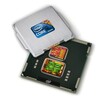Intel Core i5-480M vs Intel Core 2 Duo P9600 vs Intel Core 2 Duo SL9400
Intel Core i5-480M
► remove from comparison
Der Intel Core i5-480M ist ein zwei-Kern Prozessor für Notebooks und taktet dank Turbo mit max. 2.667 - 2.9 GHz je nach Auslastung / TDP Ausnutzung. Die zwei Kerne basieren auf die Nehalem (Westmere) Mikro-Architektur und können dank Hyperthreading 4 Threads gleichzeitig abarbeiten. Die Leistung des 480M ist in der Mittelklasse anzusiedeln. Im Vergleich zum Core i5-540M fehlen anscheinend die AES, VT-d und Trusted Execution Funktionen und der Turbo taktet etwas weniger hoch. Dafür ist der Basistakt etwas höher.
Eine Besonderheit der Arrandale Dual-Core CPUs von Intel ist die Integration des Speichercontrollers und einer integrierten Grafikkarte (GMA HD) in das Package. Die CPU wird bereits in 32nm hergestellt, der Die für den Speichercontroller und die Grafikkarte jedoch noch in 45nm.
Dank Turbo Boost Technologie kann der 480M die Rechenkerne und auch die Grafikkarte je nach Last übertakten (CPU-Kerne in 133 MHz Schritten). Dies ist jedoch von der Art der Auslastung und der Kühlung abhängig. Grafikkarte und CPU-Kerne können wahrscheinlich nicht gleichzeitig übertaktet werden. Da jedoch praktische Anwendungen und Spiele meist nicht die Kerne voll auslasten, zeigt sich der Turbo in der Praxis als äußerst wirksam. Jedoch läuft die CPU unter Last viel häufiger an der TDP Grenze, also z.B. der Core 2 Duo Vorgänger.
Dank des integrierten Speicherkontrollers, Hyper-Threading und Turbo Boost, kann sich der Core i5 im Schnitt deutlich von den gleichgetakteten Core 2 Duo Prozessoren absetzen.
Die integrierte Intel Graphics Media Accelerator HD (GMA HD) Grafikkarte soll nach ersten Berichten mit bis zu 500-766 MHz getaktet werden (mit Turbo Boost) und deutlich schneller werden als die alte GMA 4500MHD (auf Niveau einer HD 4200). Eine GeForce 9400M (ION) wird jedoch noch minimal schneller bleiben (mit besserem Treibersupport für Spiele).
Der Stromverbrauch ist mit einem TDP von 35 Watt zwar genauso hoch wie bei den T-Modellen der Core 2 Duo Serie, jedoch beinhaltet der TDP beim Core i5 auch die Grafikkarte und den Speichercontroller (beim Core 2 Duo waren diese noch im Chipsatz). Dadurch ist der Stromverbrauch des ganzen Systems wohl geringer.
Intel Core 2 Duo P9600
► remove from comparison
Der Intel Core 2 Duo P9600 ist ein sparsamer Doppelkernprozessor für Notebooks der oberen Mittelklasse. Er gehört zur Penryn Serie und wird in 45nm gefertigt. Der Prozessor war in 2009 die schnellste 25 Watt (TDP) CPU. Der etwas schnellere P9700 braucht 3 Watt mehr.
Die Performance des Core 2 Duo P9600 ist vergleichbar mit dem ebenfalls mit 2.66 GHz getakteten Core 2 Duo T9550 und dadurch sollte sie für die alle Spiele in 2009 ausreichen (nur GTA 4 profitiert deutlich von mehr Prozessorkernen oder höherem Takt). Der alte Core 2 Quad Q9000 wird auch bei den meisten Anwendungen geschlagen, da er mit nur 2.0 GHz getaktet wird.
Der Penryn (Montevina Update) Kern bietet 2 Integer Units, 1 Floating Point Unit, 1 Load Unit und 1 Store Unit in einer 14-stufigen Pipeline. Mit der Wide Dynamic Execution Technologie kann der Kern bis zu vier volle Instruktionen gleichzeitig ausführen.
Dank Dynamic Acceleration (später Turbo Modus genannt), kann sich ein Kern um eine Stufe übertakten, wenn der zweite im Idle Modus (Leerlauf) ist.
Das integrierte Enhanced Speedstep kann die Taktfrequenz des Prozessors dynamisch an die Leistungsanforderungen anpassen.
Der Core 2 Duo P9600 passt in den Socket P (mit 479 Pins)
Intel Core 2 Duo SL9400
► remove from comparison
Der Core 2 Duo SL9400 ist ein stromsparender Low Voltage Prozessor für dünne und leichte Notebooks. Er bietet den vollen 6MB Level 2 Cache des Penryn Kerns und bietet dadurch eine bessere Performance als andere 1.86 GHz Core 2 Duo Prozessoren mit weniger Cache (1-3MB üblich). Im Vergleich zum SL9380 bietet der SL9400 einen schnelleren FSB mit 1066 MHz.
| Model | Intel Core i5-480M | Intel Core 2 Duo P9600 | Intel Core 2 Duo SL9400 | ||||||||||||||||||||||||||||||||||||||||||||||||||||
| Series | Intel Core i5 | Intel Core 2 Duo | Intel Core 2 Duo | ||||||||||||||||||||||||||||||||||||||||||||||||||||
| Codename | Arrandale | Penryn | Penryn | ||||||||||||||||||||||||||||||||||||||||||||||||||||
| Serie: Core 2 Duo Penryn |
| ||||||||||||||||||||||||||||||||||||||||||||||||||||||
| Clock | 2666 - 2933 MHz | 2660 MHz | 1860 MHz | ||||||||||||||||||||||||||||||||||||||||||||||||||||
| FSB | 2400 | 1066 | 1066 | ||||||||||||||||||||||||||||||||||||||||||||||||||||
| L1 Cache | 128 KB | 128 KB | |||||||||||||||||||||||||||||||||||||||||||||||||||||
| L2 Cache | 512 KB | 6 MB | 6 MB | ||||||||||||||||||||||||||||||||||||||||||||||||||||
| L3 Cache | 3 MB | ||||||||||||||||||||||||||||||||||||||||||||||||||||||
| Cores / Threads | 2 / 4 | 2 / 2 | 2 / 2 | ||||||||||||||||||||||||||||||||||||||||||||||||||||
| TDP | 35 Watt | 25 Watt | 17 Watt | ||||||||||||||||||||||||||||||||||||||||||||||||||||
| Transistors | 382+177 Million | 410 Million | 410 Million | ||||||||||||||||||||||||||||||||||||||||||||||||||||
| Technology | 32 nm | 45 nm | 45 nm | ||||||||||||||||||||||||||||||||||||||||||||||||||||
| Die Size | 81+114 mm2 | 107 mm2 | 107 mm2 | ||||||||||||||||||||||||||||||||||||||||||||||||||||
| max. Temp. | 105 °C | 105 °C | 105 °C | ||||||||||||||||||||||||||||||||||||||||||||||||||||
| Socket | BGA1288, PGA988 | PGA478 | BGA956 | ||||||||||||||||||||||||||||||||||||||||||||||||||||
| Features | integrated DDR3 memory controller, GMA HD Graphics (500-766MHz), MMX, SSE (1,2,3,3S, 4.1, 3.2), EM64T, VT-x | Virtualization Technology (VT-x), Trusted Execution, Intel 64, Enhanced Speedstep, Execute Disable Bit | Enhanced Speedstep, Intel VT, TXT | ||||||||||||||||||||||||||||||||||||||||||||||||||||
| Architecture | x86 | x86 | x86 | ||||||||||||||||||||||||||||||||||||||||||||||||||||
| Announced | |||||||||||||||||||||||||||||||||||||||||||||||||||||||
| Manufacturer | ark.intel.com | ark.intel.com | ark.intel.com | ||||||||||||||||||||||||||||||||||||||||||||||||||||
| Voltage | 1.05-1.212V V | 1.050V - 1.150V V | |||||||||||||||||||||||||||||||||||||||||||||||||||||
| $348 U.S. | $284 U.S. |


 Deutsch
Deutsch English
English Español
Español Français
Français Italiano
Italiano Nederlands
Nederlands Polski
Polski Português
Português Русский
Русский Türkçe
Türkçe Svenska
Svenska Chinese
Chinese Magyar
Magyar
